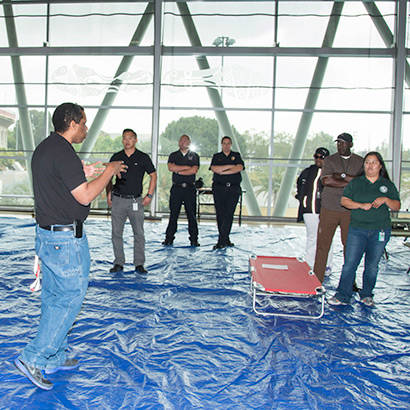
Every year, increasingly extreme weather events — hurricanes, wildfires, earthquakes, floods — wreak havoc on homes, businesses, municipalities and the environment. From 1980 to 2015, the United States averaged slightly more than five weather events per year with damages exceeding $1 billion; in the past five years (2011-2015), the annual average has more than doubled to 10.8 events. The increased frequency of these events is taking a tremendous national toll — in 2015, losses attributed to natural disasters in the United States totaled more than $16 billion.
The period of time required for a community to recover from disaster varies — some rebuild in months, others take years. In some underserved communities, the job of rebuilding is never complete. Recovery depends on a community’s level of resilience. Organizations like the United Nations and a growing number of local governments and community groups are promoting the concept of community resilience — defined as a community’s capacity to withstand and recover from significant disruptions of any kind by anticipating threats, limiting their effects and rapidly restoring functionality after a crisis — as the best approach to managing the risk of natural disasters.
Helping communities to build this capacity was the inspiration for creating the Alliance for National and Community Resilience (ANCR). During the past year, the International Code Council (ICC) has co-led the effort to create ANCR, a nonprofit alliance tasked with developing the tools, processes and metrics necessary for communities to increase their resilience. Resilient communities are not only prepared to help prevent or minimize losses and damage, but they also have the ability to quickly return citizens to work, reopen businesses and restore other essential services needed for a full and timely economic recovery.
ANCR recruited a variety of experts — emergency managers, planners and architects, and utility representatives — each focused on a unique component of community resilience. As a major first step, ANCR is creating a “Resilience Benchmark” that will identify and rate various community functions (or the services essential to the survival of a community), such as transportation, communications and business continuity.
Using the benchmark, communities will be able to:
- Better understand what resilience means in their specific community
- Determine their risk profile, which will consider and rate all of the potential risks the community faces
- Assess where they stand on a scale of resilience
- Access tools and resources to help their community become more resilient
In a time where a disaster can happen at any moment, it is important to have a plan in place for your family. In 2015, there were more than 1,500 earthquakes worldwide with about 140 of them recorded at a magnitude of 6.0 or higher. If your community is close to a major fault line, it is extremely important to identify safe places to go. The city of Portland, Oregon, is already thinking ahead by selecting 17 parks that will serve as gathering spots in case of an earthquake. Parks were chosen because of their location away from floodplains and major buildings, as well as their ability to accommodate large numbers of people. The parks are marked by signage, assuring residents that members of the community who have training will try to come to these areas to provide assistance. The Portland Bureau of Emergency Management has created Neighborhood Emergency Teams by training local residents to be able to assist first responders during a crisis.
It is important to think about how your city is vulnerable to certain types of disasters and where the safest gathering places would be, whether inside or outside. Many local recreation centers become supply hubs during natural disasters. For example, when a massive flooding of the Patapsco River occurred in July in the quaint town of Ellicott City, Maryland, community members sought refuge when their homes and businesses were destroyed. Immediately following the flood, the Roger Carter Community Center was closed for recreational use to provide shelter to people who needed a place to shower, charge devices and use bathrooms. Local park and recreation centers are convenient and safe places where the community can feel a little bit of relief during a tragedy.
While there are a number of similar initiatives, ANCR differs by placing a heavy emphasis on the stickiness of communities, that is, the elements of those places that create thriving and cohesive communities that are desirable to live in.
Parks and recreation each play a huge part in making a community desirable and comfortable to residents. Parks, from their earliest roots, help bring people together across social, economic and racial divides. They support economic development, provide safety and security, promote health and wellness, foster human development, increase cultural unity and protect environmental resources. As a leading provider of out-of-school time programming for youth, and development programs for adults and senior citizens, park and recreation centers have extensive experience in engaging community residents.
Parks also provide an ideal venue for reaching large numbers of people in order to distribute information about the benefits of community-wide resilience and to provide training for people who want to help during a disaster. In 2015, the top 26 most-visited city parks, as cited by the Trust for Public Land (only a fraction of the total number of parks throughout the country), reported a combined total of more than 230 million visitors. These facilities have a chance to shape how people think about safety and community resilience as a whole.
For many, love of local parks and recreation may help provide additional motivation to rebuild after a catastrophe, emerging stronger and more economically viable than before.
Roland Richardson is NRPA’s Development Officer, Conservation. Jennifer Cox is NRPA’s Conservation Program Specialist.

